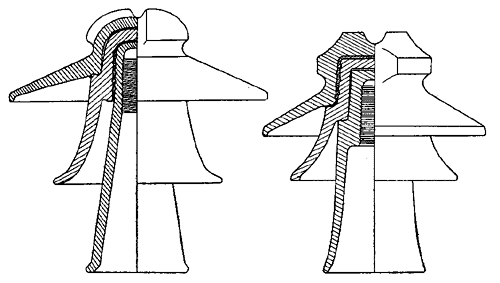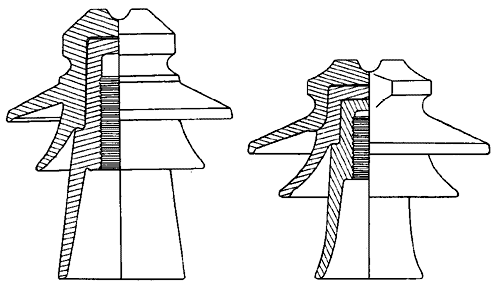[Trade Journal]
Publication: Electrical World
New York, NY, United States
vol. 50, no. 3, p. 142, col. 1-2
Porcelain Insulators for High-Tension
Circuits.
The porcelain insulators shown in section herewith have been designed by the Karlsbader Kaolin Industrie Gesellschaft, of Merkelsgriin bei Karlsbad, in Bohemia, to combine all the theoretical and practical experience thus far gained by those engaged on high-tension work. The characteristics necessary in insulators for proper protection are attained according to the various kinds of porcelain employed. On this latter point a few words on porcelain for insulation purposes may not be out of place.
Porcelain consists of a mixture of kaolin (a material made plastic in the damp state by the clay and silicic acid contained in it), quartz (silicic acid) and felspar (a dissolvable mineral consisting of clay, silicic acid and potash). The glazing is composed of the same materials with the exception that it contains a larger quantity of felspar and an addition of lime or some substance containing magnesia, in order that it may flow easily when fired. The porcelain material consists of silicates and double silicates of clay, potash and lime together with silicic acid, only mechanically combined, in which when subjected to heat, the melting molecules cement together with those not melting, but only softening.
 |
| Fig. 1. - High-Tension Insulator. |
For high tension insulators the combination of materials employed so far does not suffice; but the mass must be closely united so that its surface as an insulator may be effective. Experiments have proved that not only the flux, but also the materials richest in silicic acid possess the greatest power of insulation. On the plasticity of the kaolin depends the quantity of flux and silicic acid absorbed, and only pure Zettlitz kaolin from the company's own mines is used. While the mass must contain a certain amount of clay to give it the necessary firmness when subjected to heat, the glazing must at the same temperature become quite liquid and spread over the surface of the mass.
 |
| Fig. 2. - High-Tension Insulator. |
Insulation against loss of current in consequence of its leakage on the surface during rain or fog has been considered just as much in the construction of the insulators as insulation against puncture. The causes which bring about losses are too well known to need further mention here. The separate mantles or petticoats are so arranged that no insects or dirt can collect between them and the slope and form are such that even in heavy rains, water cannot collect. The various insulators are so constructed that with a higher tension larger upper surface insulation has been taken into consideration. An endeavor was made in the construction of the high-tension insulators to guard against the formation of sparks during rainfall. The insulators are made with petticoats which easily shed the water, and as a further protection a special porcelain carrier encircling the iron bolt rests on the support in such manner that the stretching of the wire will not affect it. These supports prevent discharges from the surface of the insulator to the bolt. The insulators are designed for cables of 5o mm. diameter and a maximum span of 75 yards. These measurements are the result of dynamic experiments, changes of temperature and the weather being taken into consideration. In the case of insulators for tensions under 15,000 volts, a thinner wall would have sufficed; but in order to insure mechanical stability, the thicker wall is preferred. The insulators shown will stand tensions of from 6000 to 60,000 volts. Each insulator is tested before shipment, the company having facilities for varying the voltage from 500 to 120,000 volts. A 180-kw, three-phase alternator is used to supply the testing transformer, and the insulators filled with water are subjected to the high tension current for two hours.
